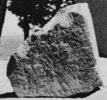Description: Fragment from the right side of a white marble stele
(w:
0.21 x h:
0.20 x d:
0.175).
Text: Inscribed on one face which has been badly and probably
deliberately defaced, possibly during the Jewish revolt of 115 CE, or perhaps by Christians.
Letters: First century CE, 0.013.
Date: First century CE
Findspot:
Cyrene:
Agora; found before 1941, and
lying in the north eastern corner of the squarein 1956.
Original location: Unknown.
Last recorded location:
Cyrene Museum.
Interpretive
[---in ea uerba quae infra scripta sunt]
[Iupiter O(ptime) M(axime) si imperator --- que]ṃ nos sen-
[timus dicere uiuet domusque eius incolumis erit a(nte) d(iem) III non(as) Ian(uarias) quae proximae P(opulo) R(omano) Quiritibus reip(ublicae)] P̣(opuli) R(omani) Quiritium
[erunt fuerint eumque diem eosque saluos seruaueris ex periculis si qua sunt eruntue ante eum diem eue]ntumque bo[nu]m
5[ita uti nos sentimus dicere dederis eosque in eo statu quo nunc sunt aut eo meliore seruaue]ṛ[is] astu ẹa iṭa f̣axis
[tunc --- donum ? auri p(ondo) ? argenti p(ondo) ---]X̣V [t]ibi datum iri uouemu[s]
[Iuno Regina quae in uerba Ioui O(ptimo) M(aximo) boue aurato uouimus esse futurum] quod hodie uouimus
[astu ea ita faxis tunc tibi in eadem uerba boue aurato uouimus esse futurum] ( vac. 1)
[Minerua quae in uerba Ioui O(ptimo) M(aximo) boue aurato uouimus esse futurum] ( vac. 1)
10[astu ea ita faxis tunc tibi in eadem uerba boue aurata uouemus esse futurum] quod hodie uouimus ------
Diplomatic
[---.............................]
[....................---...].NOSSEN
[..................................................................................].RQUIRITIUM
[.....................................................................................]NTUMQUEBO[..]M
5[...........................................................................].[..]ASTU.AI.A.AXIS
[....---....................---].V[.]IBIDATUMIRIUOUEMU[.]
[.......................................................]QUODHODIEUOUIMUS
[..............................................................]
[....................................................]
10[..............................................................]QUODHODIEUOUIMUS------
Apparatus
The hypothetical restorations of this small fragment are taken from what we know of this kind of prayer: see further below.
English translation
Translation by: Editors
(Too fragmentary for a useful translation)
Bibliography: Reynolds, 1962a, 1
Text constituted from: Transcription (Reynolds).
Images
 Fig. 1
Fig. 1. Face (Joyce Reynolds)
 Fig. 2
Fig. 2. Face
 Fig. 3
Fig. 3. Face


